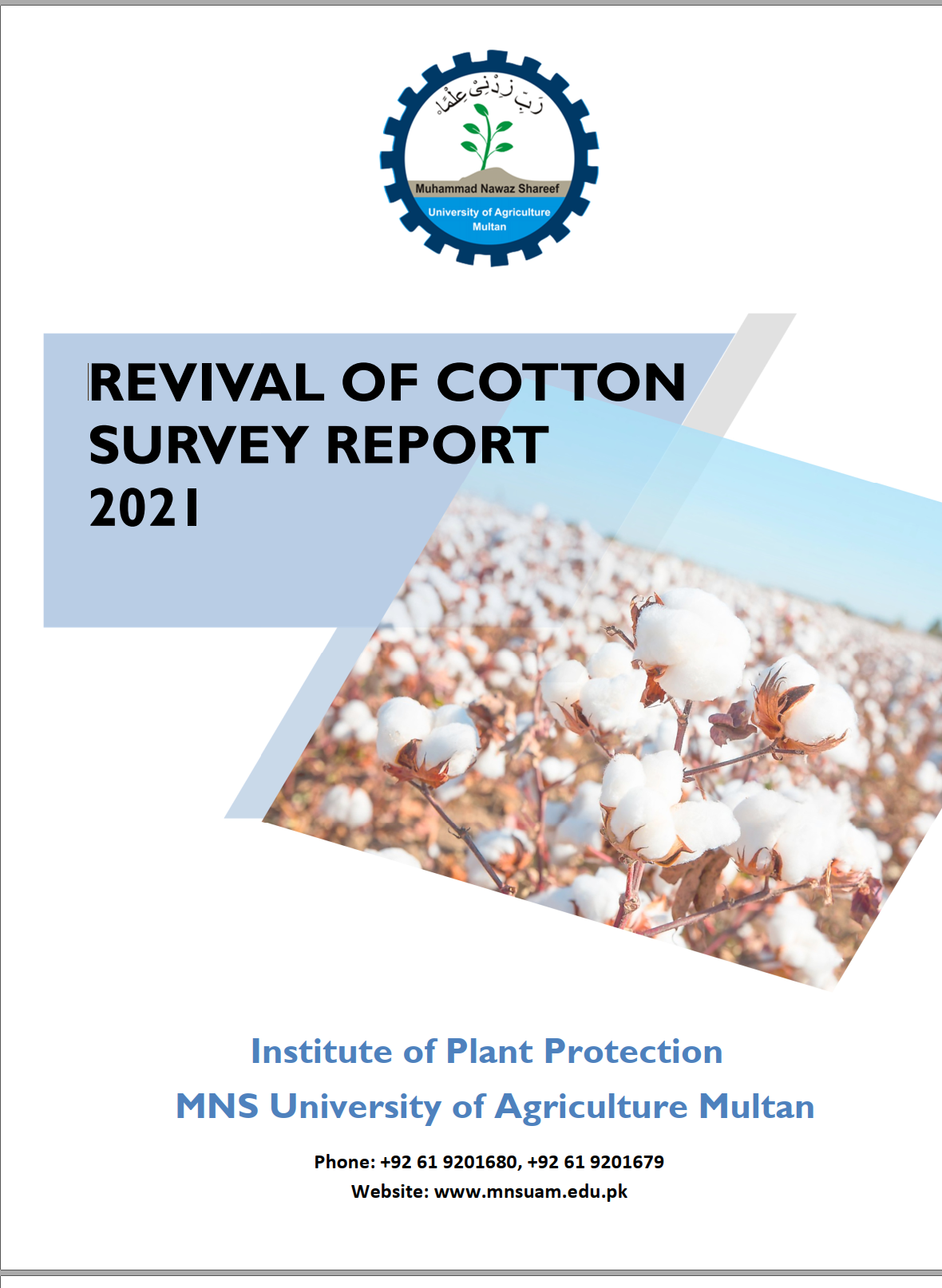Cotton in South Punjab, Pakistan: A Review of Revival of Cotton Survey Report 2021
Agriculture Department South Punjab, in collaboration with MNSUA Multan and Islamia University Bahawalpur, prepared "Integrated Pest Management" (IPM) for cotton and implemented it in the first year of setting up of South Punjab Secretariat.
The lowest ever production of 5.6 million bales in 2020-21 and difficulty to manage pests effectively during the last decade had forced the farmers to replace cotton with other crops like maize, rice, sugarcane and vegetables.

It was not strange when the land under the cotton crop declined to 3.160 million acres in 2021-22, against more than 5.00 million acres a decade ago. The decrease from the last year was hefty, about 20%. Prices of every commodity, including pesticides, fertilizers and seeds, were increasing due to COVID-19 factors. If these challenges were not enough, setting up new offices, developing infrastructure, and arranging staff were also real handicapped.
Anyway, the research teams, extension and pest warning departments, and monitoring officers made a lot of efforts. Farmers of 120 plots having a size of at least 3 acres followed regular cotton advisories from the committee working on the IPM. The initial results got the attention of the nearby farmers, and soon IPM started sounding loud.
3-Prong IPM Strategy for Cotton Crop
The Agriculture Department of South Punjab adopted a three-pronged strategy to implement the IPM.
1- 60 Days Delay in Pesticides
It was decided not to use insecticides/pesticides during the first sixty days of the crop germination. The representative bodies of the chemical industry also cooperated, and a majority of the farmers delayed the first application of synthetic pesticides.
2- Substitution of Pesticides with Biopesticides
Luckily MNSUA was already experimenting upon different biopesticides and plant extracts. However, they were not available frequently in the market. The MNSUA conducted various experiments, and the department selected low-cost and primarily free local herbs and trees to measure their mortality and repellent action upon whitefly. It was decided to use botanical mixtures instead of pesticides/ insecticides to help in delaying the application of chemicals as much as possible.
3- Avoiding consecutive application of Synthetic Pesticides
In the IPM model of cultivation, the pesticides/insecticides are delayed as much as possible with the help of cultural, biological and semiochemical controls and biopesticides. However, when pest pressure increases from a certain level, the application of pesticides becomes mandatory. However, two consecutive applications of the pyrethroids would wipe out all beneficial fauna. It was decided to avoid consecutive pyrethroids as much as possible.
The extension staff was trained to impart 'right' information to the farmers. The plant extract preparation method and application were demonstrated in fields. A layer of monitoring officers was laid to supervise the performance of the extension and pest warning staff. TV, Radio, Print and social media were utilized to disseminate bi-weekly advisories.
To understand the impact of the strategy, the MNS University of Agriculture, Multan, was requested to survey the effects of the 120 IPM demonstration plots in 11 districts and 41 revenue tehsils of South Punjab. Five survey teams of PhD students headed by Assistant Professors under Dr Shafqat Saeed Dean FA&ES/Director IPP interviewed a substantial sample of 1200 farmers, compiled results in the report, namely "Revival of Cotton Survey Report 2021."
A Brief of the Cotton IPM Survey Report
The survey has many angles. More than 93% of farmers agreed that the Agriculture Department South Punjab employees were in touch with them regularly during cotton crop management days. They have conveyed protection technology in time for implementation in cotton fields.
More than 74% of the farmers confirmed receiving information about the delay in applying pesticides by 60 or more days, and 86% had received information about biopesticides. By the start of September, Whitefly (46%), Jassid (57%), and Thrips (27%) were observed in the cotton fields.
When asked about the most harmful problem for cotton management, a majority of 51% checked the weather, 45% insecticides, 33% poor quality seed, and only 20% considered pests or insects as the most harmful factor. The teams also observed that the weather remained hot and humid, more suitable for pest growth in contradiction to the general perception. The maximum and minimum temperatures during the last seven years remained almost the same. However, if one difference is searched for, it is fewer rains during the cotton management season.
We observed sparrow nests, honey bees, butterflies and much beneficial fauna on cotton fields with minimal pesticides applications. When the farmers were asked, about 80% of them responded that they had seen beneficial insects which played a vital role in keeping the pest pressure under control or below Economic Threshold Level (ETL) for 60/90 days, as officially claimed. Astonishingly, the acceptance of the IPM was so massive that the use of pesticides reduced approximately 57% by September 2021 from 2020, in the first year of its implementation. Not only this, more than 89% of randomly selected farmers agreed to follow IPM during the cotton 2022-23 in Pakistan.
Recommendations of the Survey Team
No brief can replace the importance of the original survey report. The recommendations are so vital that I am compell to quote here for the benefits of common cotton growers as well as for the policy makers and research institutions. The original copy of the survey can either be obtained from MNSUA or Agriculture Department South Punjab, Multan.
“Based on the research trials, IPM plots of cotton installed by Agriculture Extension and Pest Warning & QCP, Departments under the guidance of the Secretary Agriculture, South Punjab, and evaluation of survey conducted from farmers by teams of MNSUAM, the following recommendations are suggested:
1. First spray of synthetic pesticides should be delayed till at least 60 days after
germination of the crop.
2. For sucking insect pests, only plant-based insecticides would be recommended
and sprayed, following regular pest scouting and ETL.
3. IPM tools like yellow sticky traps, light traps and sex pheromone traps should
be used.
4. After 60 days, environmentally safe synthetic pesticides should be
recommended, especially for chewing insect pests and bollworms.
5. Pyrethroids should not be used till the month of August.
6. Efforts to sustain and flourish biological control fauna would be made.
7. Use of pesticide mixtures should strictly be prohibited till August. The mixing of
more than two pesticides should be restricted.
8. Quality seeds of only approved varieties should be allowed for marketing.
9. Use of fertilizers should be rational based on soil analysis, especially
nitrogenous ones.
10.Support price of seed cotton should also be announced every year prior to start
of sowing season.
11.Boll pickers should be used to eradicate leftover bolls.
12.Biological control laboratories should be established at Tehsil level for mass
culture of beneficial insects like Orius bug, Encarsia/ Eretmocerus/
Trichogramma, Chrysoperla etc.
13.Research grants should be sanctioned to Research Institutes/Universities for development of bio-pesticides/natural microbial pesticides/bio-fungicides and bio-fertilizers.”
What is your IPM Story?
We find value in differences between learning, interpreting, and overall opinions. Please share your story and opinion freely about Cotton IPM 2021-22 in South Punjab, but always remain respectful. You can preview and edit on the next page before your submission is sent in. You will also be informed about this site's privacy policies. Thank you for your contribution.
